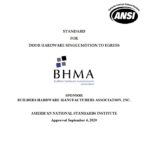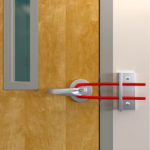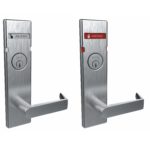 When there is a desire to lock a door in the direction of egress for security reasons, today’s Quick Question is often raised:
When there is a desire to lock a door in the direction of egress for security reasons, today’s Quick Question is often raised:
During a lockdown, is a room or area considered a “place of detention or restraint”?
The quick answer: No.
The International Building Code (IBC) mandates that most doors required for egress or provided for egress purposes must meet the code requirements. This includes unlatching the door with one releasing motion for free egress without the use of a key, tool, special knowledge or effort. These requirements help to ensure that when a building occupant needs to use a door to exit, they can do so without any barrier to egress.
The code includes two exceptions stating that doors serving “places of detention or restraint” a) are not required to unlatch with one releasing motion and b) are allowed to have locks that do not permit free egress. In the 2021 edition of the IBC, these exceptions are found in sections 1010.2.1 Unlatching and 1010.2.4 Locks and Latches.
But what is considered a “place of detention or restraint” where it would be acceptable to have doors that do not allow free egress? This issue most often comes up with regard to security products used for barricading a door during a lockdown. When I have pointed out that the doors (classroom doors, for example) must be code-compliant, some product developers have responded by saying: “During an active shooter event, the room becomes a place of detention and restraint, and the door is exempt from the codes.” This is not the intent of the IBC.
When a code requirement is not crystal clear, alternative interpretations can occur. That’s one of the reasons that the BHMA Codes, Government, and Industry Affairs Committee (BHMA CGIA) has spent so much time and effort to make changes to clarify the model codes. Based on the confusion about places of detention or restraint, I have added this to my code development wish list for the 2027 model codes. Until then, we have to rely on the IBC Commentary to help demonstrate the intent of the code. I also spoke to ICC staff to confirm my interpretation.
With regard to Section 1010.2.4 – Locks and Latches, the IBC Commentary states:
Where security and life safety objectives conflict, alternative measures, such as those permitted by each of the listed situations, may be applicable. Item 1 is needed for jails and prisons (Occupancy Group I-3).
Item 1 is applies to places of detention or restraint, and the Commentary clarifies that this is intended to apply to I-3 occupancies. Use Group I-3 is defined by the IBC as follows:
308.4 Institutional Group I-3. Institutional Group I-3 occupancy shall include buildings and structures that are inhabited by more than five persons who are under restraint or security. A Group I-3 facility is occupied by persons who are generally incapable of self-preservation due to security measures not under the occupants’ control. This group shall include, but not be limited to, the following:
– Correctional centers
– Detention centers
– Jails
– Prerelease centers
– Prisons
– Reformatories
Buildings in Group I-3 are further classified as one of five different occupancy conditions based on the level of security, and Section 408 of the 2021 IBC addresses the requirements for these facilities. This section includes detailed criteria for facilities where building occupants are not allowed to evacuate during a fire, to help ensure life safety with a defend-in-place strategy.
It’s clear from the IBC Commentary that the egress exceptions for places of detention or restraint are intended to apply to I-3 occupancies like jails, prisons, and other locations where building occupants are typically detained. A room in another type of occupancy, such as an educational or business occupancy, does not “become” a place of detention and restraint when lockdown occurs. Doors serving these spaces are required to comply with the egress requirements stated in the adopted codes. For more information about the requirements for classroom doors, refer to the Decoded article linked here.
Do you have experience or insight on this issue? I’d love to hear from you in the comments.
You need to login or register to bookmark/favorite this content.










Two places I have seen or heard of. Just putting them out.
1. Police station, they had just plain rooms, in the investigator office, that were mainly used for juvenile. The juvenile was placed in the room, till the investigator could question them, or move them somewhere else. The person could not get out of the room freely.
This was in a “B” setting.
The person in the room was supposed to have someone near the room, to keep visual contact with the room.
Legal,,, Not Legal????????
2, The other non I occupancy, is the infamous school room “””Time Out Rooms”””,
Diffidently not legal!!! But I think they are some still out there
Just putting a couple examples out there.
It was fairly common during my time in healthcare to have a room that allows the security of suicidal or violent patients. We were required to have this space under continuous visual observation. In my facilities the room was separated from an active nurses’ station by a security window (could not use a camera) and the Accrediting folks insisted on records that this occurred anytime the room was occupied, just as required. For a while there was a requirement that some means be provided to assure the presence of the observer, in our facilities it was a switch that required continuous pressure. (Big pain in the you know what.) Monder times? I don’t know.
Lori,
With regards to the “Barricade” manufacturers, I think they are looking at this from the inside out instead of from the outside in. Their thought process is backwards when they are trying to justify their products. The occupancies you mentioned are intended to keep the occupants inside for security reasons. Classrooms that are put in “Lockdown” are intended to keep someone on the outside of the room who is unauthorized, from getting into the classroom. The intent of a Lockdown scenario is not to keep the students that are in the classroom locked in but rather to keep the individuals that are the reason for the Lockdown locked out of the classroom.
Jut my $.02 worth.
Paul
I am certainly not advocating for barricade devices. I would like to see clarification in the future. With that said, I can see how someone could argue that the The 308.4 I-3 could apply to a locked down classroom.
More than 5 persons under security
Young Students not capable of self-preservation due to(regardless of) security measures beyond their control
Group is not limited to facility types listed.
The question becomes can an occupancy classification change at the press of a button? A Change of Occupancy requires a certificate from an AHJ. Is it possible an AHJ could issue a change certificate for use in times of lockdown?
The argument that a classroom becomes a place of restraint or security during a lockdown event demonstrates a lack of understanding of occupancies.
First, “An occupancy classification is the formal designation of the PRIMARY purpose of the building, structure, or portion thereof. Structures shall be classified … based on the nature of the hazards and risks to building occupants generally associated with the INTENDED PURPOSE of the building or structure.” (302.1. Emphasis added). The fact that there is a lockdown does not change the PRIMARY or INTENDED PURPOSE of a classroom. It’s still a classroom, which is under Educational Group E (305), not detention settings, which are under Institutional Group I (308).
Second, the argument misses a key term in 308.4. “Institutional Group I-3 occupancy shall include buildings and structures that are INHABITED by more than five people who are under restraint or security.” (308.4. Emphasis added). Note that this section does not say “occupied” by more than five people. It says “inhabited” by more than five people. IBC defines a habitable space as “A space in a building for living, sleeping, eating or cooking.” (202). In addition, Black’s Law Dictionary defines habitation as “The right of a person to live in the house of another without prejudice to the property.” Habitation, and therefore “inhabited” tends to focus on living in a space, not merely occupying a space.
Lastly, the argument that a classroom becomes a place of restraint or security (e.g. Group I-3) is incongruent with the language of the IBC. The IBS says that “A Group I-3 facility is occupied by persons who are generally incapable of self-preservation due to security measures not under the occupant’s control.” (308.4). If occupants barricade themselves in a room, the security measures ARE under the occupant’s control.
The argument that a classroom becomes a place of restraint or security during a lockdown has no basis in the IBC.
Lori , You failed to mention OR tried not to mention
ICC 1010.1.9.3 Locks and latches. Says:
Locks and latches shall be permitted to prevent operation of doors where any of the following exist:
Item 1.Places of detention or restraint.
Item 1 is needed for jails and prisons OR locations where someone must be kept inside for their own safety.
Hi Jack –
I did mention that section in the post – it just had a different section number because it was from a different edition of the IBC. The red italicized text in the post details the types of facilities where places of detention or restraint are permitted to be locked to prevent egress. The issue that I’ve seen is where proponents of barricade devices believe that a classroom or other space in a building that is not a prison, jail, etc., becomes a place of detention or restraint during a lockdown. This is not the intent of the codes, and it will be clarified in the next edition of the IBC and IFC.
– Lori